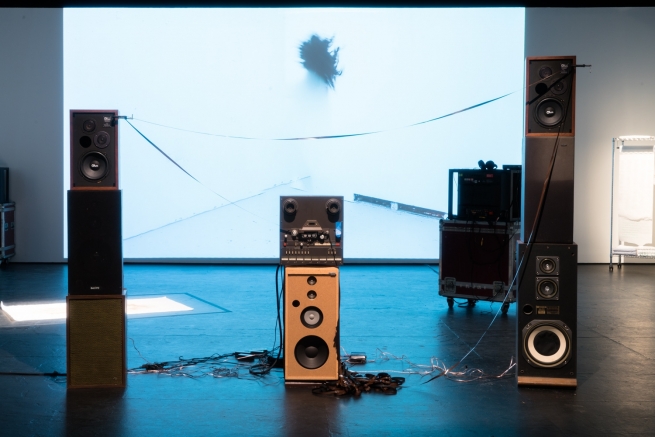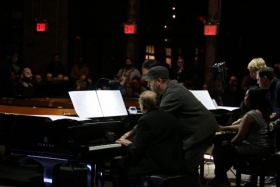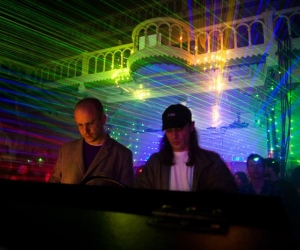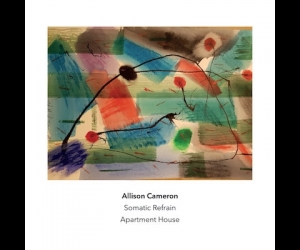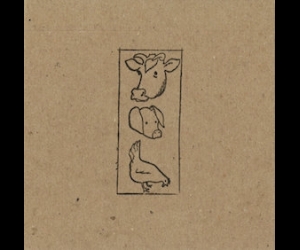At the end of February, publisher G. Schirmer, Inc. announced that it had acquired the catalogue of Julius Eastman and would be restoring, publishing, and promoting his works, putting the composer among the ranks of Tan Dun, Terry Riley, Kaaija Saariaho, Anna Thorvaldsdottir, and Tom Waits. It’s quite a distinction for a composer who died at age forty-nine, homeless and little recognized, close to thirty years ago.
It’s also a worthy move for the publishing house, but not one that comes out of the blue. The late composer has been enjoying a renaissance in recent years. His work—which can be filed under New York 1970s experimentalism between Glenn Branca and Steve Reich—has been taken up by adventurous ensembles stateside and in Europe. The New Yorker, the Los Angeles Times, and National Public Radio have recently profiled the boldly outspoken, gay, African-American composer.
Perhaps the most extensive attention given to the composer’s work of late (or ever, for that matter) came in early 2018, when The Kitchen, in Manhattan’s Chelsea neighbourhood, presented Julius Eastman: That Which Is Fundamental, a half dozen concerts and a gallery show dedicated to his output. (The series expanded upon a run of concerts in Philadelphia organized by Bowerbird under the same name in Spring 2017.) The Kitchen concerts featured some of his larger works for multiple instruments (four pianos, ten cellos, multiple singers) and some of his works that are better known, if only for their titles: Crazy Nigger, Evil Nigger, Gay Guerilla.
Some of the strongest performances came from the longstanding SEM Ensemble, led by the flutist, composer, and conductor Petr Kotik, who worked and toured with Eastman. The interlocking, overlaid phrases and dynamic shifts in Joy Boy and Femenine—both composed in 1974, both performed on the January 25 SEM concert—called to mind Kotik’s settings of Gertrude Stein, although in Eastman’s scores there is something heroic found within the modulating repetitions.
Femenine was built around a steady rhythm supplied by a pair of sleigh-bell trees attached to electric motors and by a two-part phrase played with unerring precision by David Miller. The other instruments (flute, bassoon, trombone, piano, keyboard, violin, viola) joined in slowly, playing long lines over the quick percussion patterns. Eventually, an uneasy partnership emerged between the piano and the vibes. About twenty minutes in, the bassoon (played by Sara Schoenbeck) and trombone (Christopher McIntyre) emerged from the taut phrases playing something anthemic, almost baroque, as if they were opening a can of condensed Vivaldi and pouring it into a Philip Glass bowl. It quite unexpectedly became a music about survival.
The January 28 evening concert, held at the Knockdown Center in Queens, was dedicated to works for multiple instruments. Two pieces for four grand pianos, and a third for eleven electric guitars, the latter arranged by Bowerbird founder Dustin Hurt, justified the move to the remote and cavernous space.
The piano pieces carried the inflammatory titles Evil Nigger and Crazy Nigger and were led by the wonderful Joseph Kubera, who knew Eastman in the 1970s, when they were both at the State University of New York at Buffalo. The first, Evil Nigger, was again built around modulating trills and contained another heroic subtheme, this one with a Beethoven bravado. The modifier in the title of the second piece, Crazy Nigger, would seem to apply to the composer, but could well describe the point to which players and listeners are driven: a mass of repetition, reduced after an hour to a single, repeating chord on a single piano. Nine people then walked out onto the stage and positioned themselves next to the pianos. Slowly, additional hands took to the keyboards, creating flutters within the drive. It’s the sort of thing that wouldn’t have felt significant at the quarter-hour mark. The notes on the page weren’t profound, but the experience was resonant.
Eastman’s naming of compositions wasn’t simply inflammatory. It was defiant. It was proud. It was, at least when considered in light of the music, heroic. Eastman was not writing down-on-his-luck music. He wasn’t singing the blues. He was borrowing from the baroque, from the Romantics, from the minimalists, and at the same time saying, “I am crazy, I am gay, I am black. And I am as good as you.” The sterile world of many of his minimalist contemporaries didn’t often acknowledge the past. Eastman chewed it up and spat it out again.
At the same time, monotony is written into the DNA of Eastman’s music. It’s only when his repetitions stretch to forty and sixty minutes that they begin to be felt rather than heard, that they become a part of the listener’s consciousness, that they become the world the audience is inhabiting. To drift is inevitable and to refocus the attention is to find that, while the parameters have shifted, the syntax is still familiar. This is when Eastman’s music is most deeply felt. To listen, to listen closely, is to absorb an external reality—his proud, defiant reality; it is to feel the grace of having once been lost and now being found. That is the power of Julius Eastman’s craft.
